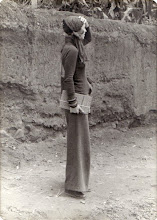In many ways the museum is a mash-up or petri dish of Bourdieu's concepts of the social and political power dynamics of the art world. As the field of production and value-creation, the "neutral space" of the museum's White Cube (O'Doherty) and institutional structure is in fact highly connected to the fields of class, power and economics. The increasing self-reflexivity of museums and their curators have led to reexamining of collections and practices both internally through carefully researched exhibits and development projects, and from outside sources such as artist curators, scholars and educators. By making room physically, financially and and in their schedules for such interventions, rather than simply housing work or validating the position of agents in the art world, museums have in some ways created a new breeding ground for art. By commissioning Stephen Antonakos to cover the exterior of the Fort Worth Art Museum in Texas with 10 outdoor neons in 1974, the then-director Richard Koshalek
increased the museum's dynamism and visibility despite its galleries being booked for the next three years.

Yet museums' efforts to address criticisms of out-of-touch elitism often put them in a tenuous position between maintaining their "power to consecrate [...]" and allowing the artist, curator, public and critic to dig up their skeletons and expose their not-so-neutral inner workings. Hans Haacke's Taking Stock made relevant the infiltration of corporate interests in the collection process, and led to the resignation of Charles Saatchi from the Tate's board. While John Baldessari curated Ways of Seeing from the 90% of the Hirshhorn's collection which remains in storage, pieces such as Janine Antoni's chocolate bust in the series "Lick and Lather" were kept from circulation, and thus cultural reanimation.

And a new wave of criticism abounds for those trying to lift the current economic damper by turning to more market aware schemes... Even the plans
for a string of museums designed by Gehry in Abu Dahbi, Vien
na and other places has been put on hold by trustees and financial gaps. That being said, not all private projects are sell-outs, or impossible models for public institutions - e.g. Di Rosa Preserve Nonetheless, some managed to strike a balance between financial sustainability, transparency and the dynamic artistic avant-garde... like MOCA's Temporary Contemporary, leased for 1$/year from LA, also initiated by Koshalek when he was Director there - originally a hardware building, it was incidentally redesigned by Gehry. Or the Hirshhorn's AfterHours, geared towards younger audiences and a great media plug. Once the museum is admittedly no longer 'just' the White Box, thinking outside the box can be a springboard for institutional change.

Of artists working outside of the museum and gallery, my mind wanders to the lecture-conferences of III (Institute of Important Ideas) by young artists Chloé Hervé & Louise Maillet in Paris - a traveling performance taking the audience along fictitious routes, e.g. the path of a crime novel hero, as a part of the geography of popular culture, "explained" in an "expert" way - much like the position taken by Fraser in Museum Highlights, reversed. III's performance takes the art crowd out, mimicking the layman's perspective on the
myths of their urban geography - rather than mimicking the museum expert to the average museum-goers.
t the most recent Venice Biennale 2009 - I'm wary of monopolistic collectors of commercially acquired fortunes like Hen
ri Pinault, but to see the astounding space created by Tadao Ando and the presentation of works by the likes of Cattelan, Jake and Dinos Chapman, even Murakami, one can only wonder if - by considering along the lines of our first reading that aesthetic beauty and the
ultimate,
 validated aesthetic is the only one that should enter a museum - one must consider then that the most "legitimate" or validated location and association for such works (outside of the strictly museum context) should be such in a space - though it pains me for some reasons that it be in such private circumstance... and 20euros to enter!
validated aesthetic is the only one that should enter a museum - one must consider then that the most "legitimate" or validated location and association for such works (outside of the strictly museum context) should be such in a space - though it pains me for some reasons that it be in such private circumstance... and 20euros to enter!
Aucun commentaire:
Enregistrer un commentaire